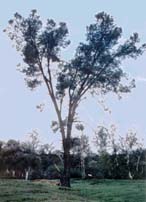 A very large specimen growing in the foothills of the Santa Lucia Mountains, California [C.J. Earle, 13-Mar-1998]. | Pinus sabiniana Douglas ex D.Don 1832Common NamesDigger, bull, gray or grayleaf pine (3).Taxonomic notesDescriptionTrees 12-21(25) m with diameters of 60-120 cm, straight to crooked, often forked; crown conic to raggedly lobed, sparse. Bark dark brown to near black, irregularly and deeply furrowed, ridges irregularly rectangular or blocky, scaly, often breaking away, bases of furrows and underbark orangish. Branches often ascending; cone-bearing branchlets stout, twigs comparatively slender, both pale purple-brown and glaucous, aging gray, rough. Buds ovoid, red-brown, ca. 1cm, resinous; scale margins white-fringed. Leaves mostly 3 per fascicle, drooping, persisting 3-4 years, 15-32 cm x 1.5 mm, slightly twisted, dull blue-green, all surfaces with pale, narrow stomatal lines, margins serrulate, apex short-acuminate; sheath to 2.4 cm, base persistent. Staminate cones ellipsoid, 10-15 mm, yellow. Ovulate cones maturing in 2 years, shedding seeds soon thereafter, persisting to 7 years, pendent, massive, heavy, nearly symmetric, ovoid before opening, broadly to narrowly ovoid or ovoid-cylindric when open, 15-25 cm, dull brown, resinous, stalks to 5cm. Scales long, thick, sharply keeled and 4-sided; apophyses elongate, curved, continuous with umbos to form long, upcurved claws to 2 cm. Seeds narrowly obovoid, thick-walled; body ca. 20 mm, dark brown; wing broad, short, ca. 10 mm, shed easily. 2n=24 (4, 5).RangeUSA: California through the Coast Ranges and the Sierra Nevada, nearly ringing the Central Valley, in dry foothills. Found at (30)300-900(1900) m elevation (4, 5). See Remarks.Big TreeSee photograph; height 37 m, diameter 156 cm, crown spread 25.1 m. Along the Nacimento-Ferguson road in the southern Santa Lucia Mountains.OldestDendrochronologyEthnobotanyThe seeds were an important food source for many Indian groups in California, sometimes collectively (and perjoratively) referred to as "digger" indians (5). The soft, lightweight wood is not durable and is used primarily as firewood (4).ObservationsSeen widely throughout its range. It can be seen in many California State Parks around the Central Valley and in Yosemite National Park, although it is strangely absent in the vicinity of Sequoia and Kings Canyon National Parks. Within the proper habitat it is abundant and well-developed groves are common.RemarksDigger pine and four species of Quercus (oaks) comprise the dominant species of the blue oak woodland, a community that essentially encircles the Central Valley. There are few shrubs, and the understory consists mainly of introduced grasses and native forbs. The mean annual temperature is 16°C and precipitation averages 530 mm. As such, the woodland is slightly hotter and drier than the chaparral, with which it forms a landscape mosaic that also includes parklands and grasslands. At increasing elevations, digger pine is restricted to open habitats on serpentine soils, being competitively displaced by Pinus coulteri and P. ponderosa (6). The role of fire in the establishment and perpetuation of digger pine is largely unknown, but the species' fecundity, short life span and occurrence in fire-prone areas all suggest that it has coevolved with relatively frequent fire.The large, heavy cones resemble footballs covered with wooden spikes. It is best to avoid the pine groves on windy days. Citations(1) Silba 1986.(2) Arno & Gyer 1973. (3) Peattie 1950. (4) Little 1980. (5) Kral in the Flora of North America online. (6) Barbour, Michael G. 1988. California upland forests and woodlands. P. 131-164 in Barbour, M.G. and W.D. Billings (eds.), "North American terrestrial vegetation." Cambridge: Cambridge University Press. See also: |
[Pinus] [Pinaceae] [home] This page is from the Gymnosperm Database |